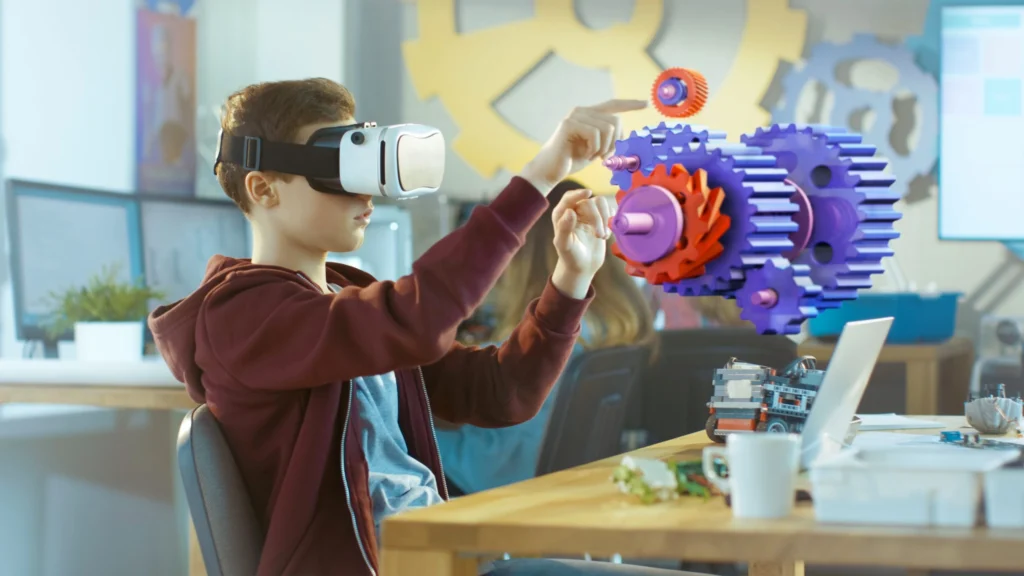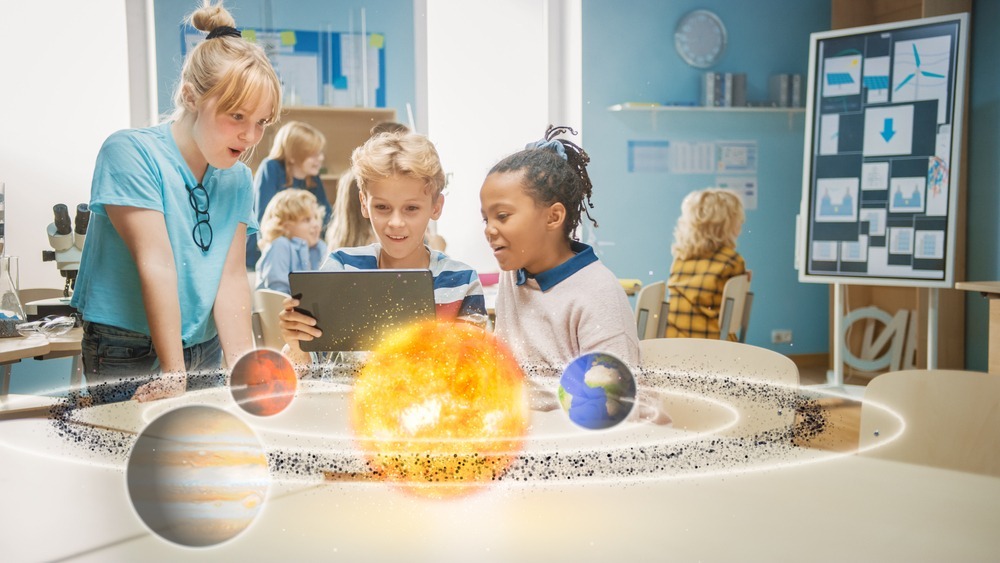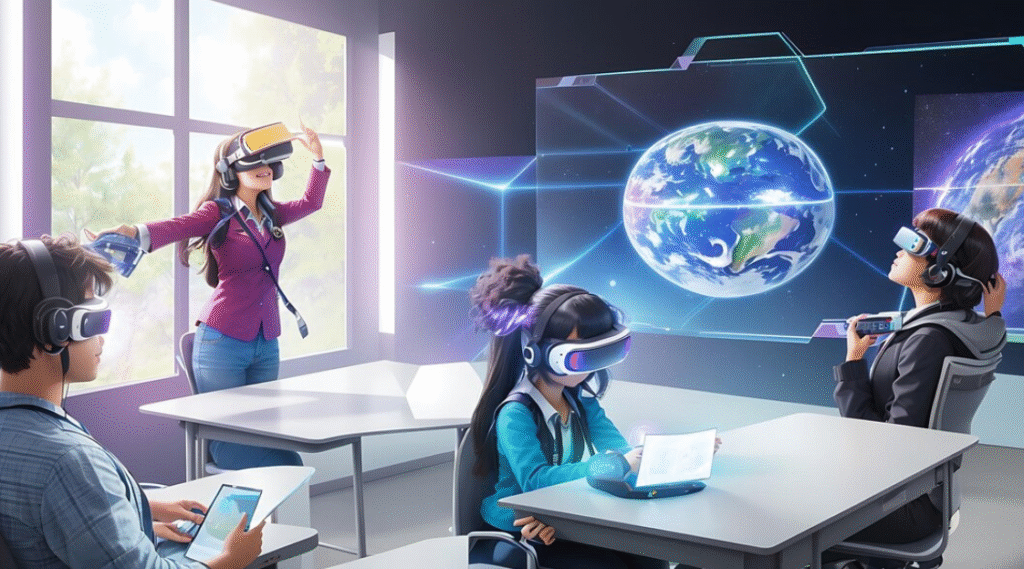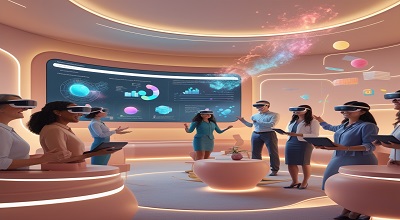AR for Teacher Training
In here AR for Teacher Training: In the rapidly evolving educational landscape, traditional teacher training methods are being supplemented—and in some cases, revolutionized—by Augmented Reality (AR). AR overlays digital information onto the real world, providing immersive and interactive learning experiences. This technology is proving to be a game-changer in teacher professional development, offering innovative ways to enhance skills, engage with content, and create dynamic learning environments.

Augmented Reality in Education
Augmented Reality (AR) is a technology that superimposes computer-generated images, sounds, or other sensations onto the real world, enhancing the user’s perception and interaction with their environment. In education, AR bridges the gap between theoretical knowledge and practical application, allowing for interactive and immersive learning experiences.
What is AR?
Unlike Virtual Reality (VR), which creates a completely synthetic environment, AR integrates and interacts with the real world in real-time. This interaction can be experienced through various devices, including smartphones, tablets, and AR glasses.
AR in Teacher Training
In the context of teacher training, AR enables educators to engage with dynamic content, simulate classroom scenarios, and practice teaching strategies in a controlled yet realistic setting. This hands-on approach enhances learning outcomes and prepares teachers for diverse classroom situations.
Benefits of AR in Teacher Training
Integrating AR into teacher professional development offers several advantages:
1. Immersive Learning Experiences
AR allows teachers to immerse themselves in simulated classroom environments, providing opportunities to practice and refine their teaching techniques without the pressure of real-world consequences.
2. Enhanced Engagement
Interactive AR applications capture attention and stimulate interest, making learning more engaging and enjoyable for educators.
3. Immediate Feedback
AR platforms can offer real-time feedback during training sessions, enabling teachers to identify areas for improvement and make adjustments promptly.
4. Personalized Learning
AR can cater to individual learning styles and paces, allowing teachers to progress through training modules at their own speed and revisit content as needed.
5. Cost-Effective Training
By reducing the need for physical materials and travel, AR can make teacher training more accessible and affordable.

Real-World Applications of AR in Teacher Development
Several institutions and organizations have successfully implemented AR in teacher training programs:
1. Virtual Classroom Simulations
Platforms like ClassVR offer virtual classroom environments where teachers can practice managing student behavior, delivering lessons, and responding to classroom dynamics.
2. Interactive Content Creation
Teachers can use AR tools to create interactive lesson plans and educational materials, enhancing student engagement and understanding.
3. Professional Development Workshops
Workshops incorporating AR allow educators to experience new teaching methodologies and technologies firsthand, improving their instructional skills.
Technological Requirements for AR Integration
To effectively integrate AR into teacher training, certain technological components are necessary:
1. AR-Enabled Devices
Devices such as smartphones, tablets, or AR glasses are essential for accessing AR content.
2. AR Software and Applications
Specialized AR applications are required to create and deliver interactive content.
3. Internet Connectivity
A stable internet connection is often needed to download content and access cloud-based AR platforms.
4. Training and Support
Educators need training on how to use AR tools effectively, along with ongoing technical support.

Challenges and Considerations
While AR offers numerous benefits, there are challenges to its implementation:
1. Accessibility
Not all educators have access to the necessary devices or internet connectivity to utilize AR technologies.
2. Technical Skills
Teachers may require additional training to effectively use AR tools and integrate them into their teaching practices.
3. Content Development
Creating high-quality AR content can be time-consuming and may require specialized skills.
4. Cost
The initial investment in AR technology and content development can be significant.
Future Trends in AR for Teacher Training
The future of AR in teacher training looks promising, with several emerging trends:
1. AI Integration
Artificial Intelligence can be integrated with AR to provide adaptive learning experiences and personalized feedback.
2. Cloud-Based Platforms
Cloud technology can facilitate the sharing and updating of AR content, ensuring that educators have access to the latest resources.
3. Collaborative Learning
AR can support collaborative learning environments where educators can work together in virtual spaces, sharing experiences and strategies.
4. Gamification
Incorporating game elements into AR training can increase motivation and engagement among educators.

Conclusion
Augmented Reality is transforming teacher training by providing immersive, interactive, and personalized learning experiences. While there are challenges to its implementation, the potential benefits make AR a valuable tool in professional development. As technology continues to advance, AR is poised to play an increasingly significant role in shaping the future of education.
Free Download: Poppy Playtime Chapter 3 APK
